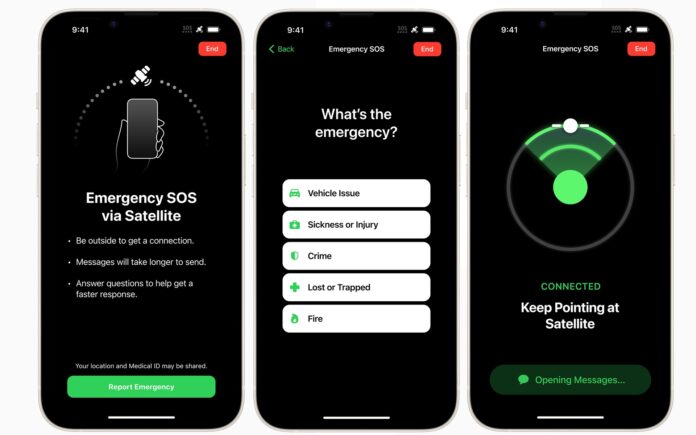Globalstar confirmed itself as the service provider behind the new feature
Apple this week unveiled the iPhone 14. The company will begin taking orders for it later this month, with delivery of some models beginning in September and continuing through October. Confirming rumors which first floated in 2021, Apple is adding emergency connectivity by satellite as a cornerstone feature of the new device. Apple calls the feature “Emergency SOS by satellite.” Globalstar has confirmed itself as the service provider behind the new feature, which will debut in November.
Apple claims “Emergency SOS by satellite” will help put users in touch with first responders to emergencies away from cellular or Wi-Fi networks. The iPhone 14 user answers a few pre-formatted questions, and is then directed to point their device at the right part of the sky to line up satellite comms. The iPhone sends short bursts of compressed information to call centers staffed by Apple-trained specialists, who the company said will then coordinate emergency ground services to help. Apple said the service will work optimally if customers have a clear view of open sky, but that it will also work (more slowly) under light foliage.
Apple said the Emergency SOS service will be available initially to customers in the United States and Canada beginning in November, as a service bundled with the iPhone 14 for free, for the first two years. Apple didn’t specify the subscription cost of Emergency SOS past the introductory period.
Apple’s “Find My” service helps users to share their location with other members of their family, and Apple said it too will get the satellite treatment for the iPhone 14. This service will offer peace of mind to iPhone 14 users and family members when they want to go off the grid but still want folks to know where they are: hiking in the mountains where there is no service, for example, or in other remote locations far away from terrestrial cell networks. In announcing Emergency SOS, Apple grouped the new feature together with crash detection, which can use G force telemetry, barometric changes and microphone sampling to detect car crashes, and will automatically attempt to dial emergency services if an event occurs.
Rumors that Apple had satellite connectivity on its mind for the iPhone kicked into high gear in early 2021, with reports that the company had selected Qualcomm’s Snapdragon X65 modem for a future iPhone. Apple historically does not comment on its supply chain, but Qualcomm’s modem supports 3GPP Release 16, enabling 5G satellite access. Despite Apple and Qualcomm’s contentious legal history, the companies continue to work together through binding, multi-year contracts. That’s despite Apple’s clear intent to control its own supply chain from the silicon on up. Those effort see Apple continuously iterating its own, System on Chip (SoC) designs elsewhere. Apple acquired Intel’s 5G smartphone modem business in 2019 and has continued to work internally on those efforts since then, but to date, the company has stuck with Qualcomm to provide essential radio technology for its products.
Satellite direct-to-phone market heats up
After temporarily suspending trading of its stock on Wednesday for news, satellite comms business Globalstar revealed itself as the service provider behind Apple’s new service. Globalstar operates a constellation of satellites in Low Earth Orbit (LEO) designed to enable satellite phones and low-speed data communication.
In a filing with the U.S. Securities and Exchange Commission (SEC), Globalstar confirmed that the two companies “have completed several milestones” including a feasibility stage, the construction, and upgrade of the ground network to support the new service, testing, and the launch of a “ground spare satellite.” The agreement puts Globalstar on the hook for allocating network capacity and Band 53 spectrum for the new service. Globalstar told the feds that there’s still a lot more work to do, both before and after Apple’s planned November launch for the service, including hiring Goldman Sachs to raise debt capital to build more satellites.
Apple’s news bookends a busy month in the Non-Terrestrial Network (NTN) business, which has been heating up throughout 2022. AST SpaceMobile is expecting to launch a test satellite this fall on board a SpaceX rocket; the company contracted the private space company to get its payload into orbit after having to scrub a planned launch aboard a Russian rocket following Russia’s invasion of Ukraine. In late August, T-Mobile and SpaceX’s satellite broadband business Starlink announced a new partnership that promises nationwide text communication by satellite in late 2023. The new service, Starlink v2, will eventually allow voice communication as well, the companies claimed. Those new satellites won’t be put in orbit until after SpaceX gets its new Starship heavy payload vehicle off the ground, hopefully later this year. And earlier this week, Lynk Global and Belgian telco BICS signed a service agreement to provide mobile operators in the Lynk Global network coverage area — which includes North America, the Caribbean, Latin America, South-East Asia and several rural areas in Africa — with extended network coverage in areas without cell towers.

